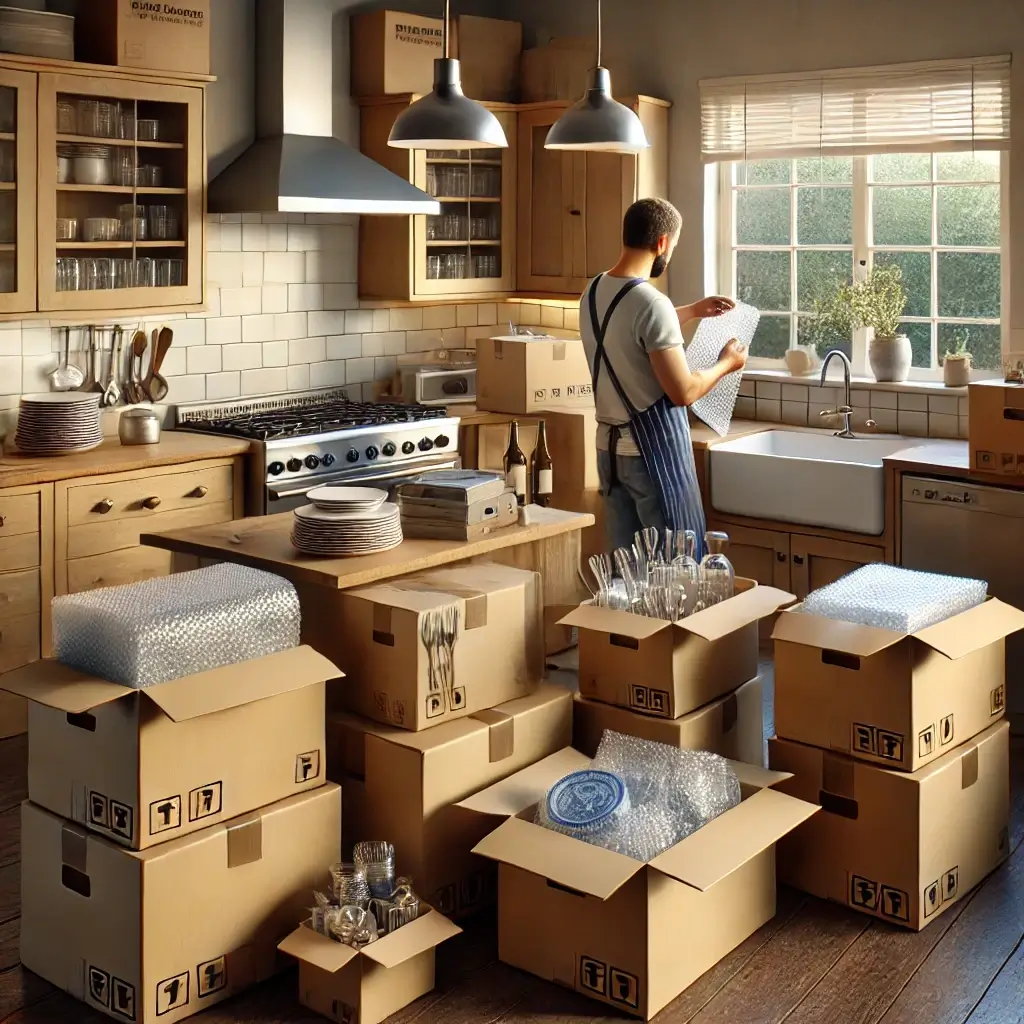How To Pack The Kitchen When Moving?
Packing up your kitchen for a move can feel like one of the toughest tasks, but it doesn’t have to be! With all the pots, pans, fragile dishes, and oddly-shaped gadgets, a kitchen is one of the most complex rooms to tackle. But don’t worry – with the right plan and a few clever tips, you can pack everything safely and keep your household running smoothly right up until move day.

Table of contents
- Why packing the kitchen is important?
- Step 1: Declutter and organize
- Step 2: Gather packing supplies
- Step 3: Keep essential items aside
- Step 4: Start packing – one area at a time
- Step 5: Label and organize your boxes
- Step 6: Packing large appliances
- Step 7: Final checklist and last-minute tips
- Conclusion: The hard part is over!
Why Packing the Kitchen is Important
Your kitchen is packed with a variety of different items, from heavy pots to delicate glasses, each needing a different approach for safe packing. With some careful planning, you can prevent breakages and make unpacking at your new home much easier. A well-organized kitchen move will help you maintain functionality until the last moment before moving day.
Step 1: Declutter and Organize
Before you even start packing, take some time to declutter. Go through your cupboards and drawers and remove items you no longer need. This is your chance to donate that old blender you haven’t used in years or toss any chipped dishes or expired pantry items. Think about what you actually use and what’s been collecting dust. Items in good condition can be donated to friends, family, or local charities, and you’ll thank yourself later for lightening the load.
Not only will this step reduce the number of things you need to pack, but it’ll also make unpacking less chaotic. Take a hard look at things like unused gadgets or worn-out kitchen tools, and let them go.
Step 2: Gather Packing Supplies
For your kitchen, you’ll need:
- Boxes: Use sturdy boxes of different sizes—small for heavy items like canned goods and medium for fragile dishes.
- Packing paper: This will be your best friend when wrapping delicate items. It’s thicker and more protective than old newspapers.
- Bubble wrap: Ideal for protecting fragile glassware, dishes, and small appliances.
- Packing tape: Use strong, durable tape to keep your boxes securely closed.
- Markers: Label everything so you know exactly where it goes when you unpack.
- Plastic wrap: The kind you use for leftovers works perfectly for securing stacks of plates, utensils, and other items that might shift around.
It’s better to overestimate how many supplies you need than run out halfway through packing. For an average family kitchen, aim for about five small boxes, ten medium boxes, and at least three rolls of packing paper.
Step 3: Keep Essential Items Aside
Since you’ll still need to use your kitchen up until the day of the move, set aside essential items. These should include:
- A plate, cup, and utensils for each family member
- A few basic pots, pans, and utensils (like a frying pan, a wooden spoon, and a cutting knife)
- Dish soap, a sponge, and a dish towel for cleanup
- Small appliances like the coffee maker or toaster that you might need daily
Pack these items last, preferably in a labeled “Essentials” box that you can unpack right away in your new home. This will save you from rummaging through boxes to find a coffee mug on your first morning!
Step 4: Start Packing – One Area at a Time
It’s time to tackle the packing process. Lay out your packing paper on the counter, grab your markers, and get to work! Here’s how to handle each category:
Dishware and Glassware
- Plates and bowls: Wrap each plate and bowl individually with packing paper, and stack them vertically (standing up) inside the box to minimize breakage.
- Glasses and stemware: Wrap each glass separately and pack them standing up. If possible, use dividers to give them extra protection. Remember, don’t put anything heavy on top of fragile glass items.
Pots, Pans, and Lids
- Nesting is key: Stack pots and pans by nesting smaller ones inside larger ones, with paper in between to prevent scratches.
- Lids: Wrap lids separately and pack them on their side or around the pots and pans.
- Use dish towels or paper to fill any gaps, keeping everything snug and secure in the box.
Small Appliances
- Prep your appliances: Clean and dry any small appliances like the blender or coffee maker. Wrap them in bubble wrap to prevent damage during the move.
- Pack them snugly: If you have the original box, great! If not, choose a box that fits well and add extra packing paper around the appliance to prevent it from shifting.
Flatware and Utensils
- Group and wrap: Use plastic wrap to keep sets of flatware together. Utensils can be bundled and wrapped in paper to prevent them from moving around.
- Knives: Be extra careful when packing knives. Roll each one in packing paper, then wrap them in a dish towel or secure them with rubber bands for safety.
Food Items and Pantry
- Check expiration dates: Toss anything that’s expired or won’t survive the move.
- Seal and pack: Pack opened food items in airtight containers to avoid spills. Canned goods and unopened items can go into small, sturdy boxes. Use a cooler for perishables if you’re moving nearby.
Step 5: Label and Organize Your Boxes
Labeling is critical when moving the kitchen. Make sure to:
- Label by category: Write what’s in each box, like “Plates” or “Glasses,” and mark it “Kitchen.”
- Mark fragile items: Clearly label boxes with breakable items as “Fragile” and indicate which side should face up.
- Color-code: You can use a color-coded labeling system to match boxes to the rooms they belong in, which makes unpacking easier.
Step 6: Packing Large Appliances
If you’re taking large appliances like a fridge, oven, or dishwasher with you:
- Unplug and clean: Defrost and clean the fridge at least 24-48 hours before moving.
- Remove detachable parts: Take out shelves, drawers, and trays and pack them separately.
- Tape doors shut: Secure any moving parts with tape and label everything to make reassembly easy.
Step 7: Final Checklist and Last-Minute Tips
Packing the kitchen takes time, so don’t rush through it. Give yourself at least a couple of days, and remember these tips:
- Avoid overpacking boxes: Heavy boxes can be difficult to move and more prone to damage. If in doubt, test the weight as you pack.
- Layering is key: Use scrunched-up paper to cushion items at the bottom of boxes and between layers to keep things from shifting.
- Keep like items together: Group similar items to make unpacking easier.
Check also: 20 Tips For Stress-Free House Move
Conclusion: The Hard Part is Over!
Packing your kitchen can feel overwhelming, but with the right approach, you’ll get through it efficiently. Start early, keep your essentials handy, and don’t forget to label everything. Once you’ve tackled the kitchen, the hardest part of your move will be behind you. Now all that’s left is to unpack and enjoy your new home – hopefully, without having to pack up your kitchen again anytime soon!
